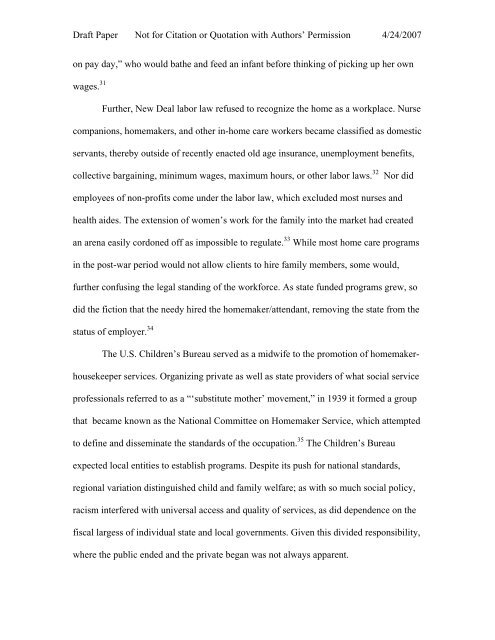Organizing Home Care: - School of Social Service Administration
Organizing Home Care: - School of Social Service Administration
Organizing Home Care: - School of Social Service Administration
You also want an ePaper? Increase the reach of your titles
YUMPU automatically turns print PDFs into web optimized ePapers that Google loves.
Draft Paper Not for Citation or Quotation with Authors’ Permission 4/24/2007<br />
on pay day,” who would bathe and feed an infant before thinking <strong>of</strong> picking up her own<br />
wages. 31 Further, New Deal labor law refused to recognize the home as a workplace. Nurse<br />
companions, homemakers, and other in-home care workers became classified as domestic<br />
servants, thereby outside <strong>of</strong> recently enacted old age insurance, unemployment benefits,<br />
collective bargaining, minimum wages, maximum hours, or other labor laws. 32<br />
Nor did<br />
employees <strong>of</strong> non-pr<strong>of</strong>its come under the labor law, which excluded most nurses and<br />
health aides. The extension <strong>of</strong> women’s work for the family into the market had created<br />
an arena easily cordoned <strong>of</strong>f as impossible to regulate. 33 While most home care programs<br />
in the post-war period would not allow clients to hire family members, some would,<br />
further confusing the legal standing <strong>of</strong> the workforce. As state funded programs grew, so<br />
did the fiction that the needy hired the homemaker/attendant, removing the state from the<br />
status <strong>of</strong> employer. 34<br />
The U.S. Children’s Bureau served as a midwife to the promotion <strong>of</strong> homemakerhousekeeper<br />
services. <strong>Organizing</strong> private as well as state providers <strong>of</strong> what social service<br />
pr<strong>of</strong>essionals referred to as a “‘substitute mother’ movement,” in 1939 it formed a group<br />
that became known as the National Committee on <strong>Home</strong>maker <strong>Service</strong>, which attempted<br />
to define and disseminate the standards <strong>of</strong> the occupation. 35 The Children’s Bureau<br />
expected local entities to establish programs. Despite its push for national standards,<br />
regional variation distinguished child and family welfare; as with so much social policy,<br />
racism interfered with universal access and quality <strong>of</strong> services, as did dependence on the<br />
fiscal largess <strong>of</strong> individual state and local governments. Given this divided responsibility,<br />
where the public ended and the private began was not always apparent.
















